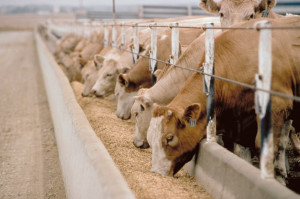Food safety friend Lynn McMullen, a professor of microbiology at the University of Alberta, told CBC News she was the victim of severe salmonella poisoning.
“I came home from California on a Sunday, and by about 7 o’clock Sunday night, my body was aching. By midnight I couldn’t decide which end of my body should be over a toilet,” she recalled.
McMullen said her doctor initially would not requisition a test for food poisoning, insisting that the problem would take care of itself.
McMullen pushed for the test, which came back positive for salmonella.
Because she was likely exposed while travelling, McMullen was not able to find out how she was infected.
McMullen said salmonella poisoning was one of the worst things she has ever gone through.
“I would never wish this on my worst enemy…I actually was at the  point where I was ready to die, it was so bad,” she said.
point where I was ready to die, it was so bad,” she said.
I have no idea why this anecdote is buried in a story from CBC about Salmonella in animal feed, other than to illustrate Salmonella is prevalent.
Canadian food inspectors find salmonella in more than 10 per cent of commercial animal feed they test despite a zero tolerance stance.
Food safety friend Rick Holley at the University of Manitoba told CBC, “We’ve got to do something about the presence of salmonella in the animal feed. It’s just insane to think we are going to be able to prevent [outbreaks] from happening unless we do something about it.”
The Canadian Food Inspection Agency (CFIA) told CBC News it does not accept any amount of salmonella in animal feed, and takes any detection seriously.
However, the agency has confirmed that it finds salmonella in 13 per cent of the feed it routinely tests.
“Reducing the potential for animals to be infected with salmonella reduces the potential that those animals will shed the organism and, as a result, contaminate animal-derived foods,” said Paul Mayers, the CFIA’s vice-president of policy and programs.
However, Mayers also said the CFIA takes a “risk-based” approach after it detects salmonella.
One Manitoba feed producer says the CFIA is only concerned with six of the more than 2,500 strains of salmonella, and it lets the feed enter the market normally if it doesn’t detect one of those six strains.
As late as in 2010, the U.S. Food and Drug Administration, like the CFIA, enforced a zero-tolerance policy for salmonella in animal feed.
This led to an import alert against four Canadian canola processors in 2009 and 2010, after several shipments of canola meal — a byproduct of the canola oil industry and a popular ingredient in animal feed — tested positive for salmonella.
For more than a year, the FDA effectively shut the U.S.-Canadian border to canola meal from Bunge, Viterra, ADM and Cargill plants in Alberta, Saskatchewan, Manitoba and Ontario.
Hundreds of shipments were stopped during this period.
But in late 2010 and early 2011, the import alert was lifted after stakeholders petitioned the FDA to relax the way the regulator deals with salmonella in feed.
Some European countries take the threat of salmonella in the food chain much more seriously than Canada does.
Ola Magnus Loemo, a spokesperson for Norway’s Ministry of Agriculture and Food, says Scandinavian countries “established strong national [salmonella] surveillance-regimes” in the mid-1990s and fought to implement tight controls on salmonella while negotiating European Union treaties.
Loemo said as a result, salmonella outbreaks are very rare in Norway, and “the majority of those cases [almost all] could be traced to contamination abroad.”
Holley said he would like to see Canada take similar steps, and he sees cleaning up our act when it comes to feed as being part of that.
“We can’t possibly hope to reduce the frequency to which these animals that we use as food shed salmonella with the hope that [our food] will not be contaminated unless we stop feeding [salmonella] to our animals,” he said.
 The guidance is intended to help animal producers develop procedures and practices to ensure the use of safe feed in animal production, FDA said. It applies to all feed offered to farm animals (including all food-producing animals and horses), whether the feed is obtained from commercial suppliers or produced on the farm. It also applies to products consumed by animals during pasture grazing, pre- or post-harvest grazing, free-range feeding and forage crop feeding.
The guidance is intended to help animal producers develop procedures and practices to ensure the use of safe feed in animal production, FDA said. It applies to all feed offered to farm animals (including all food-producing animals and horses), whether the feed is obtained from commercial suppliers or produced on the farm. It also applies to products consumed by animals during pasture grazing, pre- or post-harvest grazing, free-range feeding and forage crop feeding.



